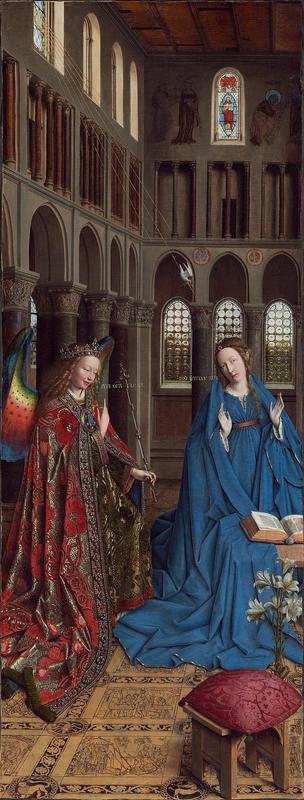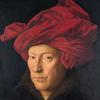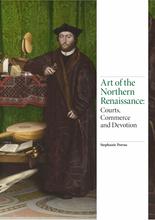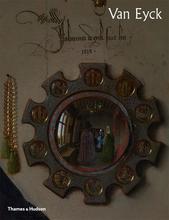More about The Annunciation
- All
- Info
- Shop

Sr. Contributor
It's the Annunciation and Mary looks super bored when she should be getting magically knocked up.
Van Eyck left this work just littered with Easter eggs. Mary and Gabriel's word bubbles are backwards and upside down so God can know what's up. Apparently, he needs subtitles. The gist of the dialogue is that Mary's gonna get pregnant and she's all, "Aight."
Christ is also referred to as the Word of God made flesh, so count the book to Mary's left as a particularly Christly and prescient Easter egg. Other bonuses from the Bible include the stories of Samson and David beheading Goliath illustrated in the scenes on the floor. The flowers at Mary's feet, lilies, are there to remind everyone that she's still got her V-card.
The painting was probably a gift from Philip the Good to a monastery in Dijon, the capital of his Duchy in Burgundy, where they also make excellent mustard. Jan was Philip's court painter and his executive assistant. Any work thrown at van Eyck was either commissioned or approved directly by Philip. From there, the painting gets a pretty fantastic pedigree. The monastery sold the painting to William II, King of the Netherlands, who then sold it to Czar Nicholas I of Russia.
One of the side effects of Russia becoming the Soviet Union was that things like fine art and land, over night, belonged to the people in trust. Rather quickly, 'in trust' took on a new meaning. It all belonged to the Soviet Union's de facto executive: Joseph Stalin. Despite an immense hatred for the Nazis, Stalin shared at least one major trait with his terrible neighbors across the bloc. A great liking for randomly declaring that some art wasn't going to be tolerated.
He must not have been a very big fan of The Annunciation, because he personally sold it and twenty other paintings from the state collection to the former American Secretary of the Treasury, Andrew Mellon. It wasn't exactly a popular decision back in Soviet Russia. The officials in charge of the Hermitage tried to act like they didn't even have a van Eyck to sell, but arguing with Stalin was a no-win situation.
Mellon treated van Eyck's birth announcement like the rest of his art collection and locked it away in a basement all for himself. Just a couple years later, the federal government brought tax evasion charges against Mellon. Suddenly, the industrialist was all about donating his multi-million dollar art collection to a foundation (read: his foundation) and working toward starting what would become the National Gallery of Art. We can thank the IRS for that one.

Contributor
Painting loaded with coded messages.
Mary’s book is flipped around so God could see the words. God can’t read upside down?
The Duke of Burgandy commissioned the painting from van Eyck, so it’s no surprise that Mary’s face closely resembles his wife's, Isabella of Portugal.
Featured Content
Here is what Wikipedia says about Annunciation (van Eyck, Washington)
The Annunciation is an oil painting by the Early Netherlandish master Jan van Eyck, from around 1434–1436. The panel is housed in the National Gallery of Art in Washington, D.C. It was originally on panel but has been transferred to canvas. It is thought that it was the left (inner) wing of a triptych; there has been no sighting of the other wings since before 1817. The Annunciation is a highly complex work whose iconography is still debated by art historians. It was bought by the Tsar of Russia for the Hermitage Museum, but was sold by Stalin's government in 1930.
The picture depicts the Annunciation by the Archangel Gabriel to the Virgin Mary that she will bear the son of God (Luke 1:26–38). The inscription shows his words: AVE GRA PLENA ('Hail, full of grace...'). She modestly draws back and responds, ECCE ANCILLA D[OMI]NI ('Behold the handmaiden of the Lord'). The words appear upside down because they are directed to God and are therefore inscribed with a God's-eye view. The seven gifts of the Holy Spirit descend to her on seven rays of light from the upper window to the left, with the dove symbolizing the Holy Spirit following the same path; "[t]his is the moment God's plan for salvation is set in motion. Through Christ's human incarnation the old era of the Law is transformed into a new era of Grace".
Check out the full Wikipedia article about Annunciation (van Eyck, Washington)
















